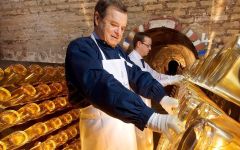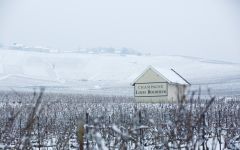Louis Roederer Brut Nature Philippe Starck Label with Gift Box 2012
-
Wine
Enthusiast -
Wilfred
Wong -
James
Suckling -
Wine
Spectator




Product Details
Your Rating
Somm Note
Winemaker Notes
Yellow in color with glints of light amber. Discreet and extremely fine bubbles. Intense bouquet combining sweet flowers (honeysuckle, broom), yellow fruits (peach) and lightly roasted dried nuts (hazelnut). Evolves towards spicy and citrus notes with a hint of Sancho pepper as well as soft, sweet, ripe notes of chestnut cream. Ample and light on entry to the palate. Ample, thanks to its sweet, creamy, almost spherical texture that seductively wraps around the mouth, coating the palate; light, due to its elegant, saline freshness that «stretches» the wine giving it a smooth, delicate and airy mouthfeel. You will not fail to be charmed by its juicy aromas of sun-drenched fruit that gently caress the palate. An elegant bitterness combined with zesty, spicy and delicate oaky notes linger on the finish.
Professional Ratings
-
Wine Enthusiast
This beautiful wine, with its poise, elegance and balance, has both a steely mineral core and an outer ripe-fruit character. It has citrus, tight acidity and rich apple and green-plum flavors.
-
Wilfred Wong of Wine.com
COMMENTARY: The 2012 Louis Roederer et Philippe Starck Brut Nature Blanc exhibits outstanding and refined notes, and shows and excellent raciness in the finish. TASTING: This wine brings green apple, chalk, and minerality to the fore. Pour a glass and enjoy it with a dozen raw oysters and plenty squirts of Meyer lemons. (Tasted: August 21, 2020, San Francisco, CA)
-
James Suckling
This has a very fresh and pure, lemony nose and is completely mouth-filling. Then it freshens and composes and takes a fine, flinty, acidity-chiseled and dry ride to the finish. Super refreshing and saline. From biodynamically grown grapes
-
Wine Spectator
This finely knit Champagne crackles with mouthwatering acidity, while the satiny mousse swathes the palate, carrying flavors of crunchy pear, rich grilled nut, white cherry and a touch of honeycomb. Long and creamy on the minerally, saline-laced finish
Other Vintages
2015-
James
Suckling -
Jeb
Dunnuck -
Robert
Parker -
Wine
Spectator






Uncompromising Quality
Champagne Louis Roederer was founded in 1776 in Reims, France and is one of the rare family owned companies, which is still managed by the Roederer family. In 1833, Louis Roederer inherited the company from his uncle and renamed the company under his namesake. Under his leadership, the company rapidly grew while remaining true to their philosophy of uncompromising quality. Today, the company is under the helm of Jean-Claude Rouzaud and his son Frédéric who continue to place quality before quantity.
First-Rate Vineyards
Champagne Louis Roederer is one of the only French champagne producers to own nearly 75 percent of the grapes in the most desirable vineyards in the Champagne. The property is located on 450 acres in the finest villages of Montagne de Reims, Côtes des Blancs, and Valleé de la Marne. Each region is selected to produce Chardonnay and Pinot Noir with the elegance needed for perfectly balanced champagne. The Louis Roederer vineyards rate an average 98 percent based on France’s statutory 100-point classification scale.
The reserve wine is then tasted and graded by a team of Roederer specialists. They choose as many as 40 different wines from several lots for the blend. For the final touch, the wine is then added in order to enhance the cuvee and guarantee consistency while retaining the champagne's characteristics.

Representing the topmost expression of a Champagne house, a vintage Champagne is one made from the produce of a single, superior harvest year. Vintage Champagnes account for a mere 5% of total Champagne production and are produced about three times in a decade. Champagne is typically made as a blend of multiple years in order to preserve the house style; these will have non-vintage, or simply, NV on the label. The term, "vintage," as it applies to all wine, simply means a single harvest year.

Associated with luxury, celebration, and romance, the region, Champagne, is home to the world’s most prized sparkling wine. In order to bear the label, ‘Champagne’, a sparkling wine must originate from this northeastern region of France—called Champagne—and adhere to strict quality standards. Made up of the three towns Reims, Épernay, and Aÿ, it was here that the traditional method of sparkling wine production was both invented and perfected, birthing a winemaking technique as well as a flavor profile that is now emulated worldwide.
Well-drained, limestone and chalky soil defines much of the region, which lend a mineral component to its wines. Champagne’s cold, continental climate promotes ample acidity in its grapes but weather differences from year to year can create significant variation between vintages. While vintage Champagnes are produced in exceptional years, non-vintage cuvées are produced annually from a blend of several years in order to produce Champagnes that maintain a consistent house style.
With nearly negligible exceptions, . These can be blended together or bottled as individual varietal Champagnes, depending on the final style of wine desired. Chardonnay, the only white variety, contributes freshness, elegance, lively acidity and notes of citrus, orchard fruit and white flowers. Pinot Noir and its relative Pinot Meunier, provide the backbone to many blends, adding structure, body and supple red fruit flavors. Wines with a large proportion of Pinot Meunier will be ready to drink earlier, while Pinot Noir contributes to longevity. Whether it is white or rosé, most Champagne is made from a blend of red and white grapes—and uniquely, rosé is often produce by blending together red and white wine. A Champagne made exclusively from Chardonnay will be labeled as ‘blanc de blancs,’ while ones comprised of only red grapes are called ‘blanc de noirs.’
